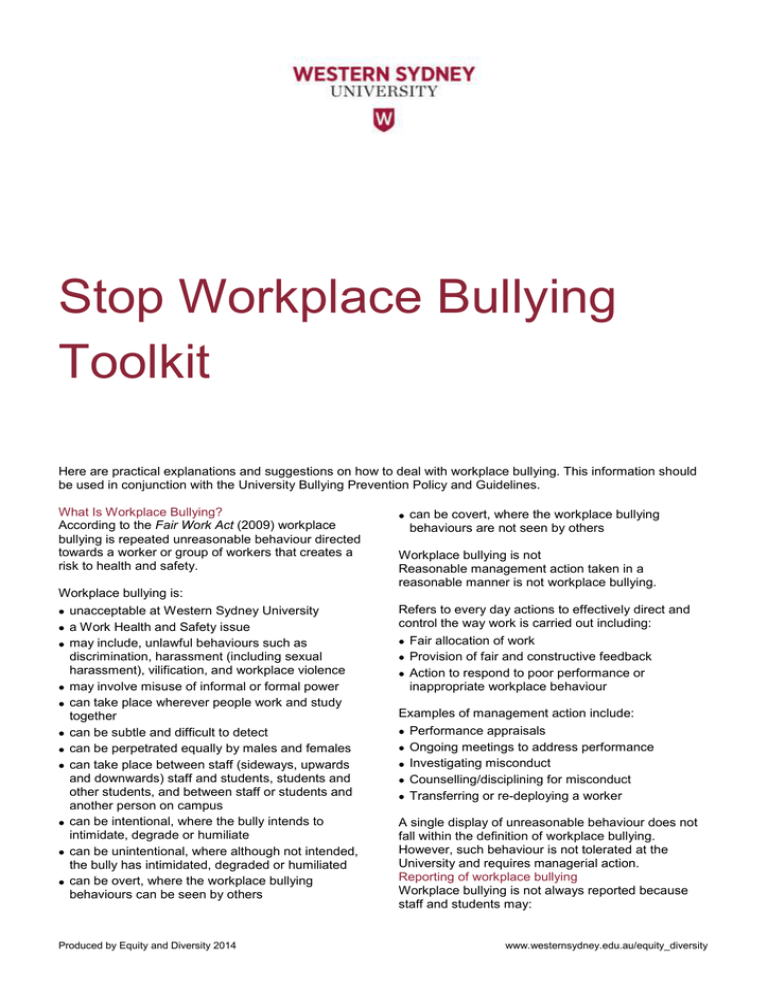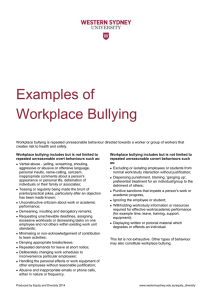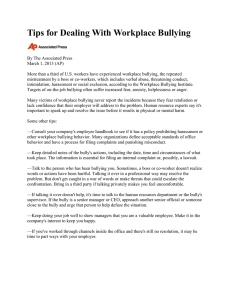Stop Workplace Bullying Toolkit
advertisement

Stop Workplace Bullying Toolkit Here are practical explanations and suggestions on how to deal with workplace bullying. This information should be used in conjunction with the University Bullying Prevention Policy and Guidelines. What Is Workplace Bullying? According to the Fair Work Act (2009) workplace bullying is repeated unreasonable behaviour directed towards a worker or group of workers that creates a risk to health and safety. Workplace bullying is: unacceptable at Western Sydney University a Work Health and Safety issue may include, unlawful behaviours such as discrimination, harassment (including sexual harassment), vilification, and workplace violence may involve misuse of informal or formal power can take place wherever people work and study together can be subtle and difficult to detect can be perpetrated equally by males and females can take place between staff (sideways, upwards and downwards) staff and students, students and other students, and between staff or students and another person on campus can be intentional, where the bully intends to intimidate, degrade or humiliate can be unintentional, where although not intended, the bully has intimidated, degraded or humiliated can be overt, where the workplace bullying behaviours can be seen by others Produced by Equity and Diversity 2014 can be covert, where the workplace bullying behaviours are not seen by others Workplace bullying is not Reasonable management action taken in a reasonable manner is not workplace bullying. Refers to every day actions to effectively direct and control the way work is carried out including: Fair allocation of work Provision of fair and constructive feedback Action to respond to poor performance or inappropriate workplace behaviour Examples of management action include: Performance appraisals Ongoing meetings to address performance Investigating misconduct Counselling/disciplining for misconduct Transferring or re-deploying a worker A single display of unreasonable behaviour does not fall within the definition of workplace bullying. However, such behaviour is not tolerated at the University and requires managerial action. Reporting of workplace bullying Workplace bullying is not always reported because staff and students may: www.westernsydney.edu.au/equity_diversity not recognise the workplace bullying behaviour not know the reporting procedure fear of retribution or 'payback' from the alleged bully, or isolation from colleagues or fellow students believe no-one will respond to their complaint fear being labelled a complainer or weak believe complaining will damage their career or study prospects accept workplace bullying as a normal part of the organisational culture Why do people engage in bullying behaviour? People who engage in bullying behaviour often have low self-esteem or they have been a victim of workplace bullying themselves. They may using workplace bullying as a way of making themselves feel more powerful. Workplace bullying behaviour may also arise from: poor communication lack of knowledge or skills fear misunderstanding jealousy inability to deal with people who are different to them or whom they do not like or value a lack of comfort with diversity and different styles of working The effects of workplace bullying Some effects of workplace bullying can show up immediately as discomfort/unease or the victim may feel 'humiliated', 'degraded' or 'undermined'. Other effects may develop over time as the workplace bullying behaviour gradually erodes an individual's or group's confidence, self-esteem and work/study performance. Effect on those experiencing workplace bullying may include: stress related illnesses, including headaches, nausea, insomnia, loss of confidence, reduced self-esteem, depression and a range of mental health conditions, suicidal thoughts, social isolation, absenteeism, overworking, reduced performance at work or in study, Produced by Equity and Diversity 2014 fear of an inability to continue working or studying due to the effects of workplace bullying, fear of losing employment/study opportunity and economic/career devastation. Effects on those witnessing workplace bullying may include: fear that they might be the next target and therefore withdraw or resign guilt that they are not stopping the behaviour anger and resentment that nothing is being done about it fear of retribution if they intervene or take sides. Effects on the University environment (study or work): reduced employee or student productivity and motivation increased absenteeism breakdown in communication and teamwork loss of experienced and skilled staff through resignation increased student drop-out rates increased workers compensations claims and costs reduced commitment and respect for the organisation damaged organisational reputation. What can you do if you are bullied or you witness workplace bullying? What you can do about workplace bullying differs on the circumstance and your role at the University. Whether you are a victim, an alleged bully, or a witness you have a responsibility to take action and there are many options available to you to do something about workplace bullying. If you are a manager or supervisor you have a legal duty to deal with workplace bullying that is reported to you. If you are being bullied or have witnessed it there are a range of things that you can do. The list of options below is not exhaustive and the order is not prescriptive - it is a list of suggestions that can assist you to take action. Every situation is different. Option 1 Think about the situation Take some time to think about the situation - try to shed light on what is going on and ask yourself what is causing the conflict and why the person might be behaving in the way you perceive. Also, consider www.westernsydney.edu.au/equity_diversity whether the behaviours that are upsetting you are workplace bullying as defined above. Option 2 Don't be isolated Don't be isolated - talk to someone, like a colleague, a fellow student, a family member, or a friend, about the workplace bullying. Discuss whether the alleged bully's behaviour is unreasonable and if there is anything you can do to improve the situation and feel stronger. Option 3 Record workplace bullying behaviours Record the behaviours that you think amount to workplace bullying - make sure you describe the behaviours that are upsetting you and note the date, time, place, and who else was around. Also record the effect that the workplace bullying has had on you - for example: what have you felt at work or when studying, at home, did you take days off, and have you been to the doctor. Option 4 Get some support Get some support - you can do this within the university such as contacting the Employee Assistance Program or Student Support Services if you are a student. You can also look for a counsellor outside of work, in places such as local health centres or your medical centre. Option 5 Seek information and advice Seek information and get some advice - read the Bullying Prevention Policy and Guidelines and check that the situation falls within the definition of workplace bullying. If you are a staff member, you can contact your Business Partner at the Office of People and Culture, or Equity and Diversity. If you are a student contact Student Support Services and ask them for advice about your options. Option 6 Make a decision about your options Decide which option you want to take - you may want to sort it out completely by yourself or you may want to work with others to address the situation. Note that you must report the workplace bullying to your manager/supervisor and once they are aware of the workplace bullying, they have a duty to do something about it according to the particular circumstances. Option 8 Report the workplace bullying to a manager/supervisor If you are a staff member report workplace bullying to your manager/supervisor and if that person is the alleged bully, then report it to their manager/supervisor. If you are a student, report it to your lecturer or Head of School. Remember to use your notes to show that the behaviour is workplace bullying. That is, that it is a pattern of unreasonable behaviour that has the potential to harm your health and well-being. Ask your manager/supervisor what will happen next. Your manager/supervisor or lecturer/head of school has a duty to you as a staff member or student, so they will have to choose an appropriate response to the report of workplace bullying. The response will depend on the situation. Option 9 Talk to the alleged bully Try to talk to the alleged bully if you feel you can. It may help the other person realise the effects of their behaviour on you and they may stop the workplace bullying. Option 10 Stay informed Stay informed - ask your manager/supervisor for regular updates on the progress of the matter and if there is anything that you need to do. Option 11 Make a formal internal complaint Make a formal internal complaint – If the matter has not been resolved locally you can make a formal internal complaint the Complaints Resolution Unit. They will ask you what you have done to try to resolve it at your local level before they can investigate the complaint. See the Complaints Handling and Resolution Policy. Option 7 Complete WHS form Complete a Work Health and Safety Form outlining the problem and the steps you have taken to address the situation. Produced by Equity and Diversity 2014 www.westernsydney.edu.au/equity_diversity





